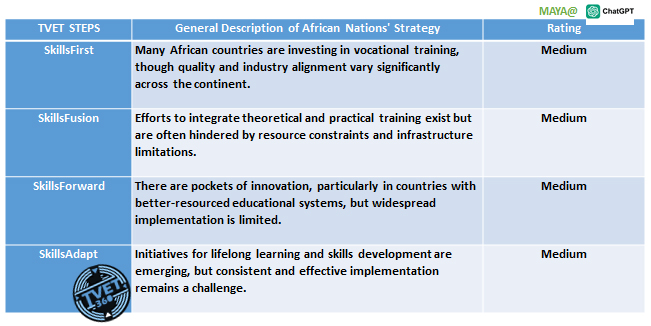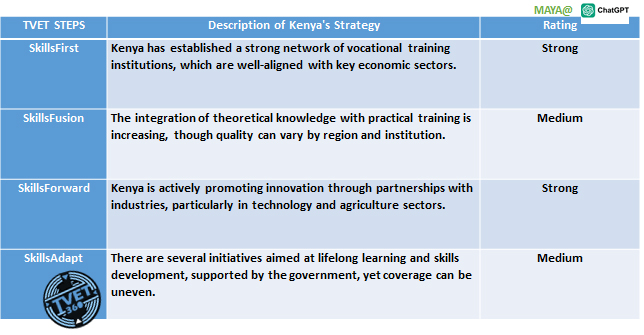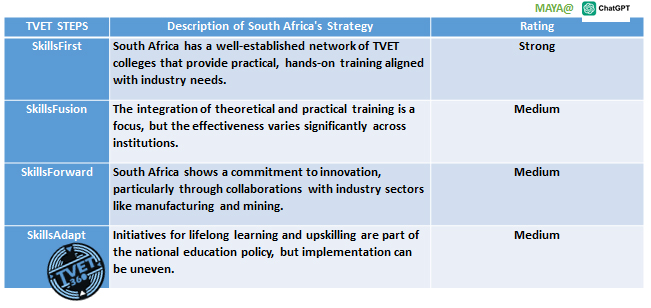3/10 - TVET STEPS and The African Nations
 Nana Azhar
Nana Azhar
Summary
Evaluating TVET strategies across African nations also requires acknowledging the diverse levels of development, resources, and focus on vocational education within the continent. Here, I'll provide a general assessment using the TVET STEPS Rubric, focusing on typical features across a broad range of African countries:

Explanation:
SkillsFirst: While there is a commitment to developing vocational training, the execution and quality vary, with some nations having well-developed programs and others still in early stages.
SkillsFusion: Integration of theory and practice is recognized as important, but challenges such as funding, teacher training, and educational materials often impact the effectiveness of these programs.
SkillsForward: Innovation in TVET is growing, especially in more economically stable countries. However, for many nations, these innovations are not yet at the stage where they significantly impact the broader educational landscape.
SkillsAdapt: Although there is an increasing awareness of the importance of lifelong learning, the infrastructure and systems to support it comprehensively are not yet widespread.
To have a better look at how some nations fare within these region, let view several cases form this region.
CASE #1

Kenya TVET strategy across the TVET STEPS

Explanation:
SkillsFirst: Kenya's emphasis on practical, hands-on training that meets the needs of its growing economy, particularly in agriculture and technology, merits a strong rating.
SkillsFusion: Efforts to blend theoretical and practical learning are underway, with some institutions leading the way. However, more consistency across the board is needed.
SkillsForward: Kenya shows strong innovation in its TVET programs, especially through initiatives that link training with emerging industries and technologies.
SkillsAdapt: While there are policies in place for continuous learning and adaptation to new skills, the effectiveness and reach of these programs vary, leading to a medium rating.
CASE #2

South Africa's TVET strategy across the TVET STEPS

Explanation:
SkillsFirst: South Africa excels in providing robust practical training through its extensive network of TVET colleges, strongly aligned with the needs of its diverse economic sectors.
SkillsFusion: There are ongoing efforts to blend theoretical knowledge with practical applications effectively. However, the quality and delivery of this integration can be inconsistent, which impacts the overall success of these programs.
SkillsForward: The country is proactive in promoting innovation within its TVET system, especially in collaboration with key industries. However, these initiatives are not yet widespread or impactful enough to earn a higher rating.
SkillsAdapt: South Africa recognizes the importance of lifelong learning and has policies aimed at promoting it. Still, the reach and effectiveness of these programs are variable, leading to a medium rating.
Disclaimer
All evaluations conducted by TVET360 are for educational purposes only. Although these evaluations are valid and based on reliable sources, they are not intended to degrade, belittle, or criticize any country. We respect the unique strengths, cultures, and challenges of each nation. For the most accurate and personalized information, individuals should consult local experts, official sources, and consider the specific context of their situation.
Thank you for your time ❤️
Subscribe to my newsletter
Read articles from Nana Azhar directly inside your inbox. Subscribe to the newsletter, and don't miss out.
Written by
